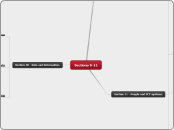ICT Recap: Sections 9 to 11.
Section 9 - ICT systems and their components.
SHIPPED
Software
Hardware
Information
People
Procedured
Data
What is ICT?
ICT is the use of technology for the input,
processing, storage and transfer of data
and the output of information.
What is an ICT system?
ICT is the use of technology for the input,
processing, storage and transfer of data
and the output of information. This information
can then be used by human beings or other
ICT systems.
Section 11 - People and ICT systems.
Interfaces
Menu driven
good for small tasks
slow for experienced users
limited options
natural language
easy to use
Command line
need to know commands
need experience using command line interface
does not use many system resources
is the most powerful of the interfaces
Graphical User Interface
WIMP- windows, icons, menus, pointers.
can customise
easy to use
high system resources needed
makes use of natural language
Characteristice of the users- PETE
environment of use
physical ability and age
experience
tasks to be undertaken
Personal skills- FOGWEPT
flexible
oral communication
good
written communication
excellent
problem solving and patience
team work
Team skills - BUSGEMS
balance of skills
understanding of requirements
strengths and weaknesses identified
good communitcation
excellent team leader
monitoring progress and costs
standardised documentation
Job roles
systems analyst
programmer/designer
webmaster
ICT technician
network manager
rollout engineer
helpdesk operator
software tester
technical editor
User support methods
other users
chatting to friends, email support, forums.
3rd party
email, dvd tutorials, knowledge base, bulletin board, user manuals, chat helpline.
Software house
email, chat helpline, dvd tutorials, user manuals
help within software package, hover over text,
knowledge base on website
Section 10 - Data and information.
How data arises
Direct data is collected for a specific purpose.
This is the original source.
Indirect data is the reuse of original source data
for a completely different purpose.
Data
Raw facts and figures with no meaning or value
Four types
Text
email address, phone number,
name etc.
Numbers
exam mark, age price (£)
Images
still/moving, digital photograph or recorded video
Sound
recorded sound
Coding and Encoding
Coding is the shortening of data.
Increses input speed, is more accurate, (less GIGO), less hard disk storage. Loses detail and need to know the codes.
Encoding is the conversion of data into binary.
This is done so that the computer can 'read' the data that is being input as computers only understand binary.
